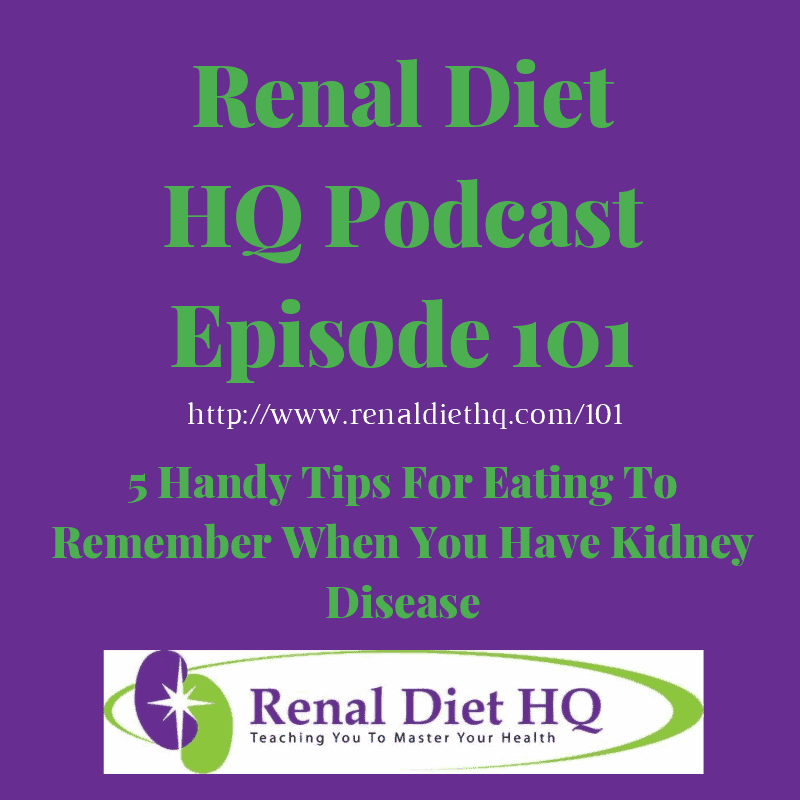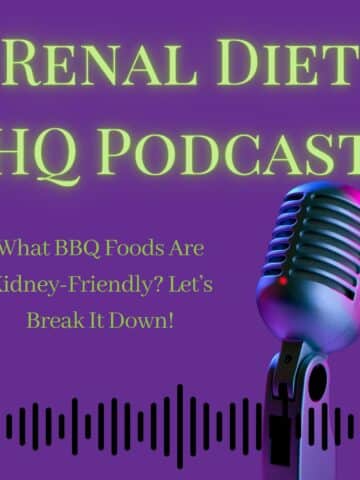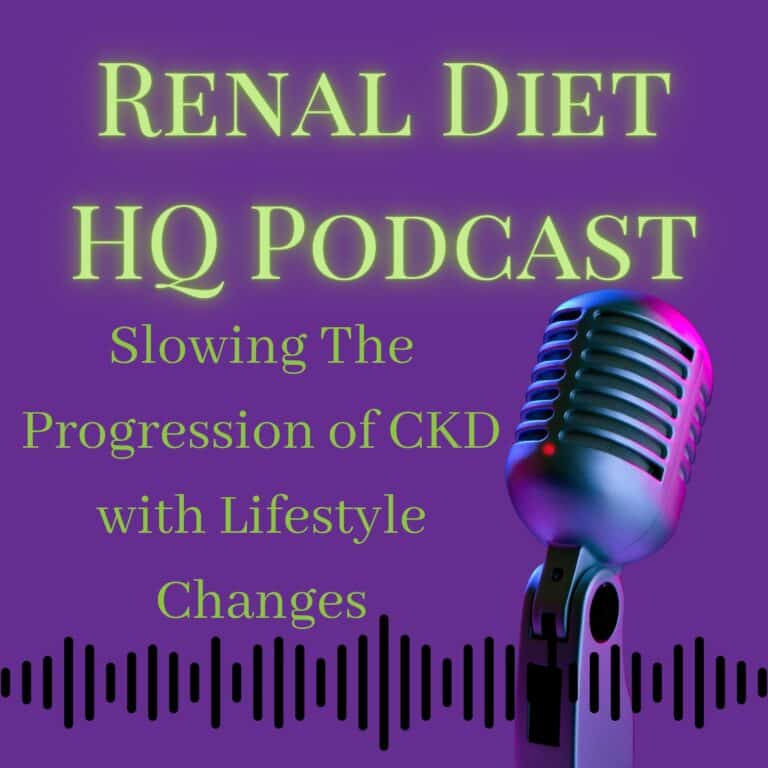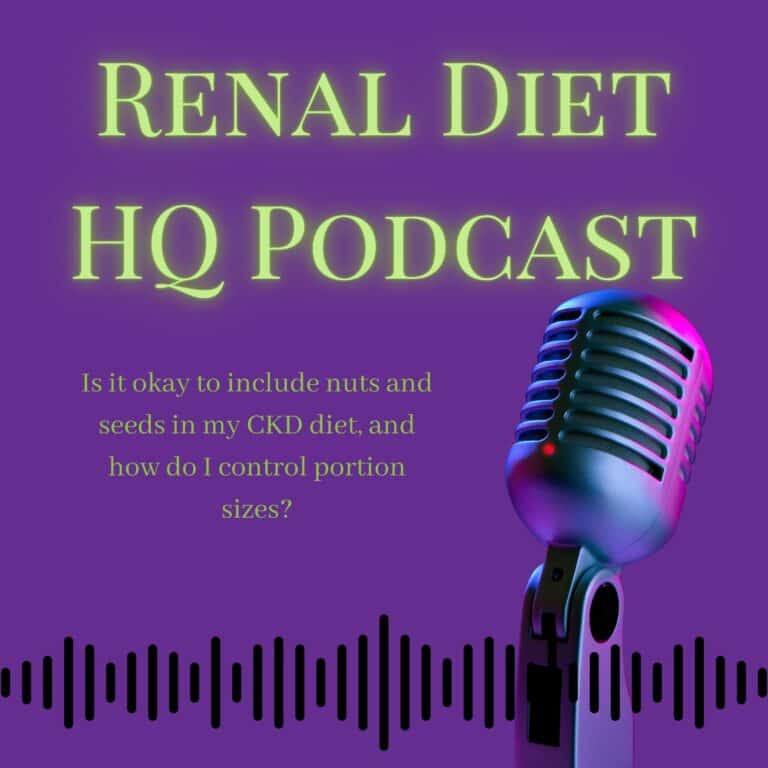RDHQ Podcast 101: 5 Handy Tips For Eating To Remember When You Have Kidney Disease
Podcast: Play in new window | Download

Hi there! It's Mathea Ford with Renal Diet HQ and today I wanted to do a live and talk to you about some handy tips for eating to remember when you have chronic kidney disease and I'm going to go over five tips that I have for you but I want to remind you that it's really important to try to manage some of your eating and to do it kind of slowly not like pull off the band-aid kind of quickly.
When you try to follow a kidney-friendly diet, it isn't always just as simple as like eating the healthiest options because sometimes your seemingly ingredients that are good for you can have high levels of phosphorous and if you're worried about phosphorus, if your lab levels show that you have high levels of phosphorous, then those can be bad decisions or you know maybe something you should choose less often or potassium amounts. If you're worried about your potassium and your potassium levels are high, then you certainly should manage the amount of potassium that you eat. Not everyone has to limit their phosphorus or potassium so don't just automatically reduce that or don't automatically change that.
The things that we know that you should change that would be the most helpful when you have chronic kidney disease are eating less sodium and eating lower amounts of protein. Those help with your creatinine and other levels in your body. These five tips should help you remember what to eat when you're kind of making that choice.
Number one: Back away from Beige. If you're worried about potassium you need to choose things that are not whole as much whole grain. Now, I for one want you to eat some whole grains because I know they're healthy for you. You need the fiber, you need the extra that's got extra vitamins and nutrients in it but you need to watch out for eating too much whole grain.
Now, in the US, I don't know that that's a huge problem but you can get fiber in other ways as well. You can get it from vegetables, you can get your oatmeal or other like hot cereals but just watch out for those like whole-grain bread and brown rice if you're worried about potassium.
If you're not worried about it you certainly should steer towards those things because they have more fiber and more natural vitamins and minerals that are very helpful to you and healthy for your heart.
Number two: If you are concerned about phosphorus you probably want to switch out your dairy. If you have high levels of phosphorus. If you're in late stage 4 or early stage 5 or on dialysis, you're probably going to switch out your milk to something that is more has less phosphorous like unflavored rice milk and it's really something that you probably would want to do as you moved towards later stages of kidney disease but not when you're in stage 3 and stage 4 kidney disease you can still drink regular milk. You just still need to pay attention to the amount of protein that's in regular milk because 8 ounce glass of regular milk has as much protein as an ounce of meat or poultry so you have to balance that when you're trying to control the amount of protein that you're eating.
Number 3: Red is best when it comes to fruit. This one's really kind of easy for you. A handy rule of thumb for choosing fruits is to generally stick with the red options like red berries, strawberries apples, watermelon. Yellow fruits like bananas or orange like oranges can be higher in potassium and so people tend to steer away from those. I always think of it as a great balance between how many you... Balance.
Eating a little bit of some is not going to be a bad thing. Eating too much is going to be what's going to cause the problem. If you find yourself overly eating you know bananas every afternoon, you might want to balance that out with eating some berries or some apples that can or grapes that are also healthy, also have fruit, have fruit or fiber and yet are not as high in potassium.
Fourth: Opt for the least salty meats. Most fresh meat isn't too salty, just really need to watch what you're putting on it. You know if you're using like a rub or marinade, make sure you don't have extra salt in that. You can read the label and look at the ingredients list but think of your meat options in terms of how much salt. You have your higher salt things or more processed foods like your hotdogs, your deli meats.
You might steer clear of bacon or eat less bacon or sausage because it's not only high in sodium but it can be high in fat and so you want to manage how much of that you're getting but think of eating less salty meat so don't be adding salt to meat and use more fresh cuts or frozen. You know you could have frozen chicken breasts when you thought it's like it's fresh and as long as it hasn't been injected with extra salt, sodium preservatives then you can feel pretty healthy eating that.
And number five: Portion control counts. Now, when you're thinking about managing your chronic kidney disease the things you want to look at are protein and sodium. I've already said that but when you read the label, it's going to quote to you based on what the amount of the serving is so you want to know how much that is but if you want some general guidelines you've probably heard this before but I'll repeat it. A three-ounce portion of meat which most people can eat between 3 and 9 ounces of meat a day is the size of the palm of your hand and about you know that thick or the size of a deck of cards. It doesn't seem very big and you should definitely fill your plate with those vegetables and fruits and grains that allow you to feel full but aren't overdoing it with the protein.
I want to think about cheese. Some people like to eat little cubes of cheese as a snack or whatever so about one cube is usually about an ounce the size of a dice that you can roll. And most juice portions are four ounces and the fat portion is typically like the amount on your thumb - that thumb pad. So, if you think about you know a portion of butter or margarine that's what you would think of it as.
Overall I wanted to just remind you that there are some ways that you can make kind of some healthier choices in the minute. If you're at a restaurant and you're looking at a salad, if it comes with you know apples and some walnuts and chicken breast that's not fried that's going to be a healthy choice and then look at some oil and vinegar or vinaigrette type dressings.
You want to try to manage how much protein you're eating and how much salt you're eating by choosing less salty meats, less processed foods, watch out for those red items and the bananas and the oranges eating a little less often. And when you're transitioning it's easy to have kind of these guidelines.
I also want to remind you that as time goes on you'll find your balance where you want to how much you can eat and I don't want you to go overboard so I want you to kind of slowly start to incorporate more healthy things and get rid of those things that seem to be less healthy for you based on your lab results.
If you're interested in learning more about like understanding your kidney test results, understanding what your labs are you can go to RenalDietHQ.com and click on the Understanding Your Kidney Test Results menu item and that's where you can find out more information about the course that I have about understanding your kidney test results and it tells you what it goes over there but it goes over all these different labs that you might be concerned about when you first find out you have kidney disease and I'll also put a link to that below this video.
Thanks for listening today and I'll talk to you soon!
Learn more About Kidney Disease Friendly Mocktails and Drinks For When You Cannot Drink More Water
Learn more About RDHQ Podcast 102: How To Stay Kidney Friendly While Dining Out









